Strategies for Regulating Natural Monopolies: An Economic Analysis
VerifiedAdded on 2019/11/26
|9
|2648
|267
Report
AI Summary
This report delves into the economic rationale behind regulating natural monopolies, which are characterized by a single firm efficiently supplying an entire market due to high entry barriers and economies of scale. The core argument emphasizes the government's role in ensuring fair pricing and efficient operations, exploring options like public ownership or regulation of privately-owned entities. The analysis highlights the potential for unfair practices if unregulated, given the firm's market power and the essential nature of its product. The report then examines various regulatory strategies, including marginal cost pricing, average cost pricing, price caps, and peak load pricing, evaluating their impact on consumer welfare and the sustainability of the monopoly's operations. It contrasts unregulated pricing with regulated scenarios, illustrating how regulations can impact output levels, pricing, and consumer surplus. The report concludes by recommending the maintenance of natural monopolies as sole providers while emphasizing the importance of tailored regulations to address specific market conditions and prevent market power abuse.
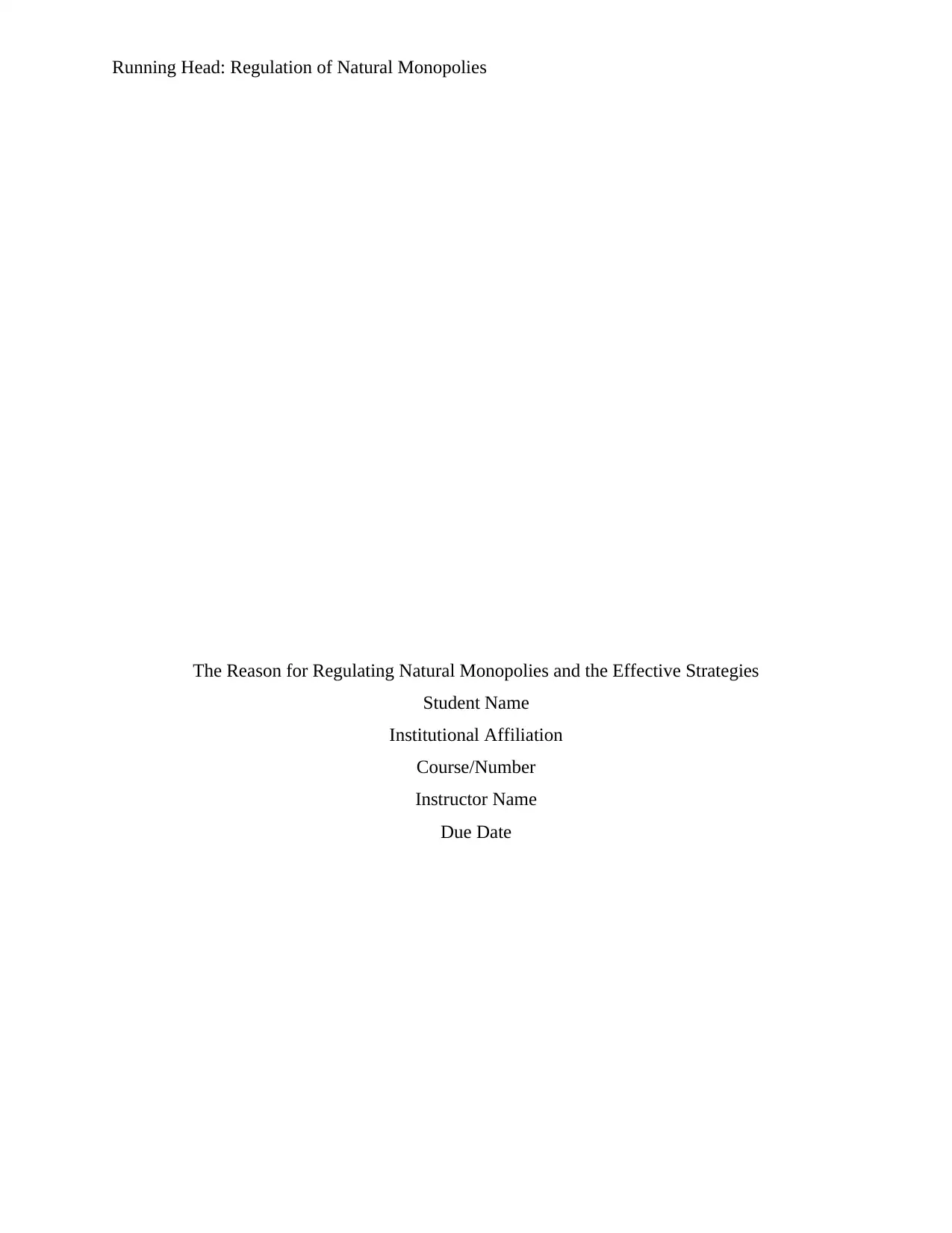
Running Head: Regulation of Natural Monopolies
The Reason for Regulating Natural Monopolies and the Effective Strategies
Student Name
Institutional Affiliation
Course/Number
Instructor Name
Due Date
The Reason for Regulating Natural Monopolies and the Effective Strategies
Student Name
Institutional Affiliation
Course/Number
Instructor Name
Due Date
Paraphrase This Document
Need a fresh take? Get an instant paraphrase of this document with our AI Paraphraser

Regulation of Natural Monopolies 2
The Reason for Regulating Natural Monopolies and the Effective Strategies
Introduction
A natural monopoly is a single firm that supplies a certain line of product for the whole
market. It originates from the definition of monopoly where a single seller suppliers the entire
market (Bennett & Coleman, 2017). This firm has the ability to produce high level of output at a
lower cost (Molinuevo & Sáez, 2014). This ability is created by the presence on entry barriers
and the fact that the single firm has increased economies of scale. The government has a role of
ensuring that businesses are operated efficiently and that the output is sold at a fair price. The
government has two options to ensure fair pricing is observed; one is that it can own the natural
monopoly or it can regulate those that are privately owned (McEachern, 2013). The notion that
the natural monopoly needs to be regulated is self-explanatory that there is a possibility of unfair
practices if the single firm is left to operate with no regulation (Int'L Business Publications,
2015). The major reason why the government should regulate this firm is because it is the only
firm that the whole economy depends on and that the product is on high demand and thus a high
possibility of high pricing. Economic regulation has two view; one is that it is interested in the
consumers’ or public welfare by controlling the natural monopoly where a single firm’s
production is more efficient than in a competitive industry. The other view is that producers are
interested in the regulation because they depend on it when fixing prices, raising profits and
creating entrance barriers. This paper will try to determine whether there is more benefit in
regulating a natural monopoly rather than encouraging competition. It will also identify the
group that benefit much from the regulation.
The theories put forward to explain the strategies the government should implement to
regulate the natural monopolies are many. Some of the theories to be covered are the marginal
cost pricing, average cost pricing, price caps, etc. All these theories try to establish the way in
which the goods offered by the natural monopoly is affordable to the citizens and thus an
improvement in social welfare. Other theories such as capture theory and public interest theory
shows the interests the government have under regulation. The capture theory tell us that the
regulator are interested with the operations of the producer. The public interest theory poses that
the interest of the government is on maximizing social welfare by preventing an abuse of market
power.
Student’s Name: Student’s ID
The Reason for Regulating Natural Monopolies and the Effective Strategies
Introduction
A natural monopoly is a single firm that supplies a certain line of product for the whole
market. It originates from the definition of monopoly where a single seller suppliers the entire
market (Bennett & Coleman, 2017). This firm has the ability to produce high level of output at a
lower cost (Molinuevo & Sáez, 2014). This ability is created by the presence on entry barriers
and the fact that the single firm has increased economies of scale. The government has a role of
ensuring that businesses are operated efficiently and that the output is sold at a fair price. The
government has two options to ensure fair pricing is observed; one is that it can own the natural
monopoly or it can regulate those that are privately owned (McEachern, 2013). The notion that
the natural monopoly needs to be regulated is self-explanatory that there is a possibility of unfair
practices if the single firm is left to operate with no regulation (Int'L Business Publications,
2015). The major reason why the government should regulate this firm is because it is the only
firm that the whole economy depends on and that the product is on high demand and thus a high
possibility of high pricing. Economic regulation has two view; one is that it is interested in the
consumers’ or public welfare by controlling the natural monopoly where a single firm’s
production is more efficient than in a competitive industry. The other view is that producers are
interested in the regulation because they depend on it when fixing prices, raising profits and
creating entrance barriers. This paper will try to determine whether there is more benefit in
regulating a natural monopoly rather than encouraging competition. It will also identify the
group that benefit much from the regulation.
The theories put forward to explain the strategies the government should implement to
regulate the natural monopolies are many. Some of the theories to be covered are the marginal
cost pricing, average cost pricing, price caps, etc. All these theories try to establish the way in
which the goods offered by the natural monopoly is affordable to the citizens and thus an
improvement in social welfare. Other theories such as capture theory and public interest theory
shows the interests the government have under regulation. The capture theory tell us that the
regulator are interested with the operations of the producer. The public interest theory poses that
the interest of the government is on maximizing social welfare by preventing an abuse of market
power.
Student’s Name: Student’s ID

Regulation of Natural Monopolies 3
Analysis
Pettinger (2012) gave several types of natural monopolies and argued that it is more
efficient for a single firm to supply the whole economy than a multiple of firms. The reason he
posed out is that the fixed costs for the single firm is high and that there is a huge capital
requirement to initiate the distribution of the resources supplied by a natural monopoly. He
argued that the average cost for the multiple firms would be higher compared to the single firm
because this firm already has significant economies of scale. Some of the examples given include
tap water; laying of pipes to supply to the entire economy is capital intensive, electricity; its
distribution networks are very expensive to initiate, railway transportation; the cost of laying the
rails is very high and thus not practically available for competition, the gas distribution and
postal services, etc. Economies of scale is the advantage of reduced costs of production enjoyed
when a natural monopoly firm produced high level of output as shown in the image below.
Fig: Natural monopoly’s economies of scale
Cost
ACa
ACc
ACb LRAC
D
Qa Qb Quantity
The economies of scale creates a rationale for the government to allow the operation of a
natural monopoly rather than allowing competition in this industry. The Average cost of
producing Qa units by a multiple of producers is Aca, whereas the cost for producing the higher
level quantity Qb by the same natural monopoly is ACb. If a single firm is able to produce
quantity Qb at a cost ACB, let’s assume that there was entrant of another firm in this industry; if
Qb is the maximum level of demand, then it means that the two firms will produce the same
Student’s Name: Student’s ID
Analysis
Pettinger (2012) gave several types of natural monopolies and argued that it is more
efficient for a single firm to supply the whole economy than a multiple of firms. The reason he
posed out is that the fixed costs for the single firm is high and that there is a huge capital
requirement to initiate the distribution of the resources supplied by a natural monopoly. He
argued that the average cost for the multiple firms would be higher compared to the single firm
because this firm already has significant economies of scale. Some of the examples given include
tap water; laying of pipes to supply to the entire economy is capital intensive, electricity; its
distribution networks are very expensive to initiate, railway transportation; the cost of laying the
rails is very high and thus not practically available for competition, the gas distribution and
postal services, etc. Economies of scale is the advantage of reduced costs of production enjoyed
when a natural monopoly firm produced high level of output as shown in the image below.
Fig: Natural monopoly’s economies of scale
Cost
ACa
ACc
ACb LRAC
D
Qa Qb Quantity
The economies of scale creates a rationale for the government to allow the operation of a
natural monopoly rather than allowing competition in this industry. The Average cost of
producing Qa units by a multiple of producers is Aca, whereas the cost for producing the higher
level quantity Qb by the same natural monopoly is ACb. If a single firm is able to produce
quantity Qb at a cost ACB, let’s assume that there was entrant of another firm in this industry; if
Qb is the maximum level of demand, then it means that the two firms will produce the same
Student’s Name: Student’s ID
⊘ This is a preview!⊘
Do you want full access?
Subscribe today to unlock all pages.

Trusted by 1+ million students worldwide
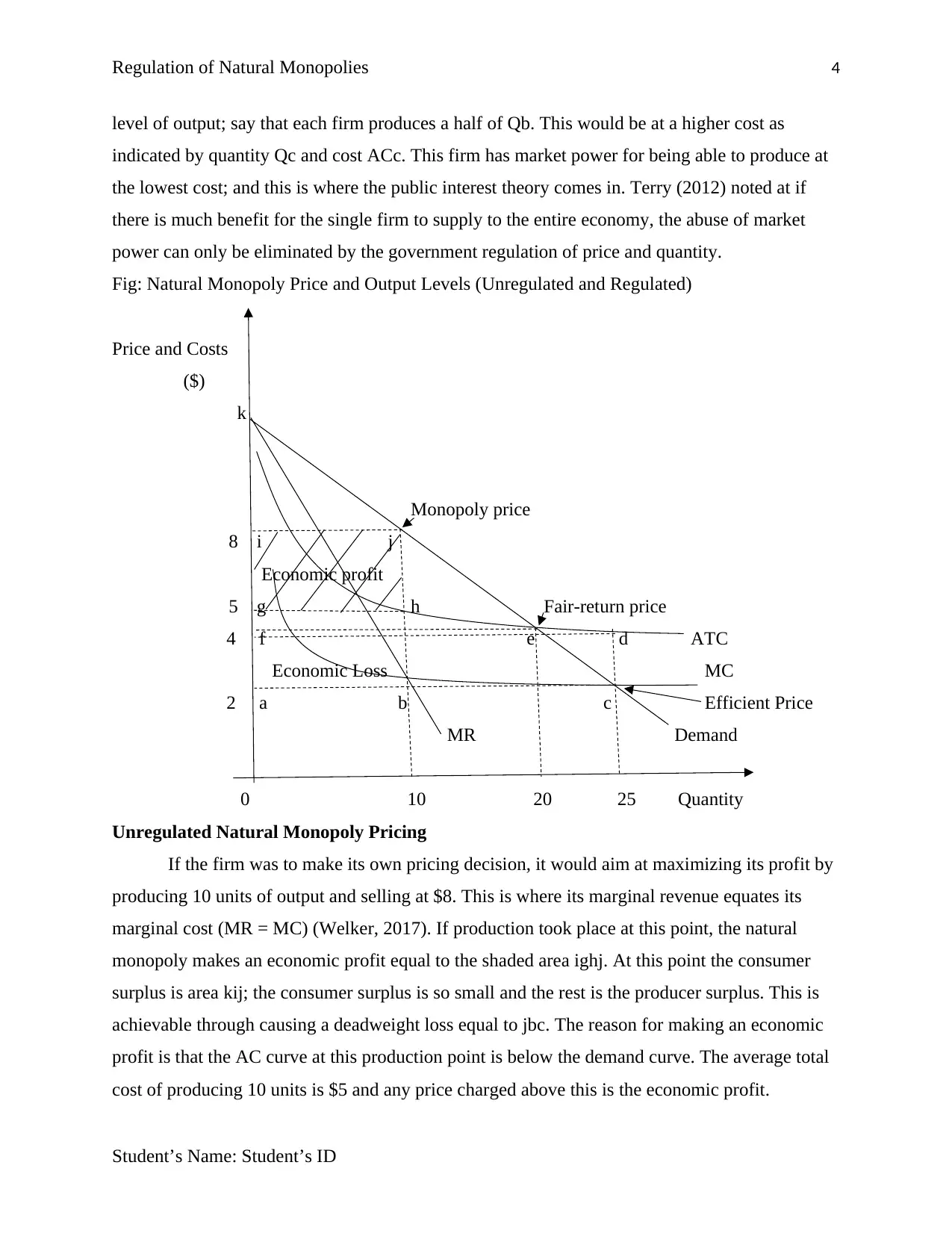
Regulation of Natural Monopolies 4
level of output; say that each firm produces a half of Qb. This would be at a higher cost as
indicated by quantity Qc and cost ACc. This firm has market power for being able to produce at
the lowest cost; and this is where the public interest theory comes in. Terry (2012) noted at if
there is much benefit for the single firm to supply to the entire economy, the abuse of market
power can only be eliminated by the government regulation of price and quantity.
Fig: Natural Monopoly Price and Output Levels (Unregulated and Regulated)
Price and Costs
($)
k
Monopoly price
8 i j
Economic profit
5 g h Fair-return price
4 f e d ATC
Economic Loss MC
2 a b c Efficient Price
MR Demand
0 10 20 25 Quantity
Unregulated Natural Monopoly Pricing
If the firm was to make its own pricing decision, it would aim at maximizing its profit by
producing 10 units of output and selling at $8. This is where its marginal revenue equates its
marginal cost (MR = MC) (Welker, 2017). If production took place at this point, the natural
monopoly makes an economic profit equal to the shaded area ighj. At this point the consumer
surplus is area kij; the consumer surplus is so small and the rest is the producer surplus. This is
achievable through causing a deadweight loss equal to jbc. The reason for making an economic
profit is that the AC curve at this production point is below the demand curve. The average total
cost of producing 10 units is $5 and any price charged above this is the economic profit.
Student’s Name: Student’s ID
level of output; say that each firm produces a half of Qb. This would be at a higher cost as
indicated by quantity Qc and cost ACc. This firm has market power for being able to produce at
the lowest cost; and this is where the public interest theory comes in. Terry (2012) noted at if
there is much benefit for the single firm to supply to the entire economy, the abuse of market
power can only be eliminated by the government regulation of price and quantity.
Fig: Natural Monopoly Price and Output Levels (Unregulated and Regulated)
Price and Costs
($)
k
Monopoly price
8 i j
Economic profit
5 g h Fair-return price
4 f e d ATC
Economic Loss MC
2 a b c Efficient Price
MR Demand
0 10 20 25 Quantity
Unregulated Natural Monopoly Pricing
If the firm was to make its own pricing decision, it would aim at maximizing its profit by
producing 10 units of output and selling at $8. This is where its marginal revenue equates its
marginal cost (MR = MC) (Welker, 2017). If production took place at this point, the natural
monopoly makes an economic profit equal to the shaded area ighj. At this point the consumer
surplus is area kij; the consumer surplus is so small and the rest is the producer surplus. This is
achievable through causing a deadweight loss equal to jbc. The reason for making an economic
profit is that the AC curve at this production point is below the demand curve. The average total
cost of producing 10 units is $5 and any price charged above this is the economic profit.
Student’s Name: Student’s ID
Paraphrase This Document
Need a fresh take? Get an instant paraphrase of this document with our AI Paraphraser
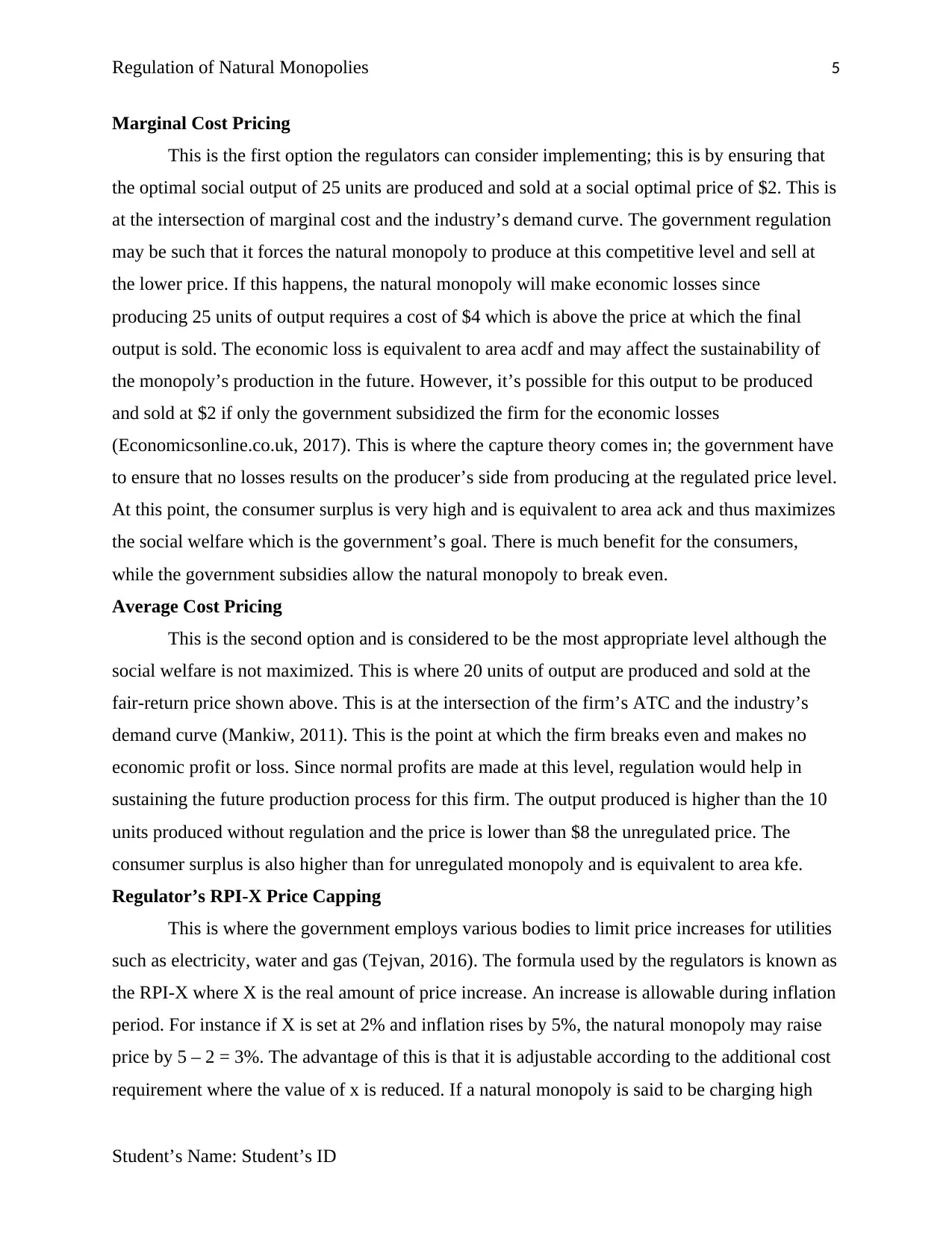
Regulation of Natural Monopolies 5
Marginal Cost Pricing
This is the first option the regulators can consider implementing; this is by ensuring that
the optimal social output of 25 units are produced and sold at a social optimal price of $2. This is
at the intersection of marginal cost and the industry’s demand curve. The government regulation
may be such that it forces the natural monopoly to produce at this competitive level and sell at
the lower price. If this happens, the natural monopoly will make economic losses since
producing 25 units of output requires a cost of $4 which is above the price at which the final
output is sold. The economic loss is equivalent to area acdf and may affect the sustainability of
the monopoly’s production in the future. However, it’s possible for this output to be produced
and sold at $2 if only the government subsidized the firm for the economic losses
(Economicsonline.co.uk, 2017). This is where the capture theory comes in; the government have
to ensure that no losses results on the producer’s side from producing at the regulated price level.
At this point, the consumer surplus is very high and is equivalent to area ack and thus maximizes
the social welfare which is the government’s goal. There is much benefit for the consumers,
while the government subsidies allow the natural monopoly to break even.
Average Cost Pricing
This is the second option and is considered to be the most appropriate level although the
social welfare is not maximized. This is where 20 units of output are produced and sold at the
fair-return price shown above. This is at the intersection of the firm’s ATC and the industry’s
demand curve (Mankiw, 2011). This is the point at which the firm breaks even and makes no
economic profit or loss. Since normal profits are made at this level, regulation would help in
sustaining the future production process for this firm. The output produced is higher than the 10
units produced without regulation and the price is lower than $8 the unregulated price. The
consumer surplus is also higher than for unregulated monopoly and is equivalent to area kfe.
Regulator’s RPI-X Price Capping
This is where the government employs various bodies to limit price increases for utilities
such as electricity, water and gas (Tejvan, 2016). The formula used by the regulators is known as
the RPI-X where X is the real amount of price increase. An increase is allowable during inflation
period. For instance if X is set at 2% and inflation rises by 5%, the natural monopoly may raise
price by 5 – 2 = 3%. The advantage of this is that it is adjustable according to the additional cost
requirement where the value of x is reduced. If a natural monopoly is said to be charging high
Student’s Name: Student’s ID
Marginal Cost Pricing
This is the first option the regulators can consider implementing; this is by ensuring that
the optimal social output of 25 units are produced and sold at a social optimal price of $2. This is
at the intersection of marginal cost and the industry’s demand curve. The government regulation
may be such that it forces the natural monopoly to produce at this competitive level and sell at
the lower price. If this happens, the natural monopoly will make economic losses since
producing 25 units of output requires a cost of $4 which is above the price at which the final
output is sold. The economic loss is equivalent to area acdf and may affect the sustainability of
the monopoly’s production in the future. However, it’s possible for this output to be produced
and sold at $2 if only the government subsidized the firm for the economic losses
(Economicsonline.co.uk, 2017). This is where the capture theory comes in; the government have
to ensure that no losses results on the producer’s side from producing at the regulated price level.
At this point, the consumer surplus is very high and is equivalent to area ack and thus maximizes
the social welfare which is the government’s goal. There is much benefit for the consumers,
while the government subsidies allow the natural monopoly to break even.
Average Cost Pricing
This is the second option and is considered to be the most appropriate level although the
social welfare is not maximized. This is where 20 units of output are produced and sold at the
fair-return price shown above. This is at the intersection of the firm’s ATC and the industry’s
demand curve (Mankiw, 2011). This is the point at which the firm breaks even and makes no
economic profit or loss. Since normal profits are made at this level, regulation would help in
sustaining the future production process for this firm. The output produced is higher than the 10
units produced without regulation and the price is lower than $8 the unregulated price. The
consumer surplus is also higher than for unregulated monopoly and is equivalent to area kfe.
Regulator’s RPI-X Price Capping
This is where the government employs various bodies to limit price increases for utilities
such as electricity, water and gas (Tejvan, 2016). The formula used by the regulators is known as
the RPI-X where X is the real amount of price increase. An increase is allowable during inflation
period. For instance if X is set at 2% and inflation rises by 5%, the natural monopoly may raise
price by 5 – 2 = 3%. The advantage of this is that it is adjustable according to the additional cost
requirement where the value of x is reduced. If a natural monopoly is said to be charging high
Student’s Name: Student’s ID
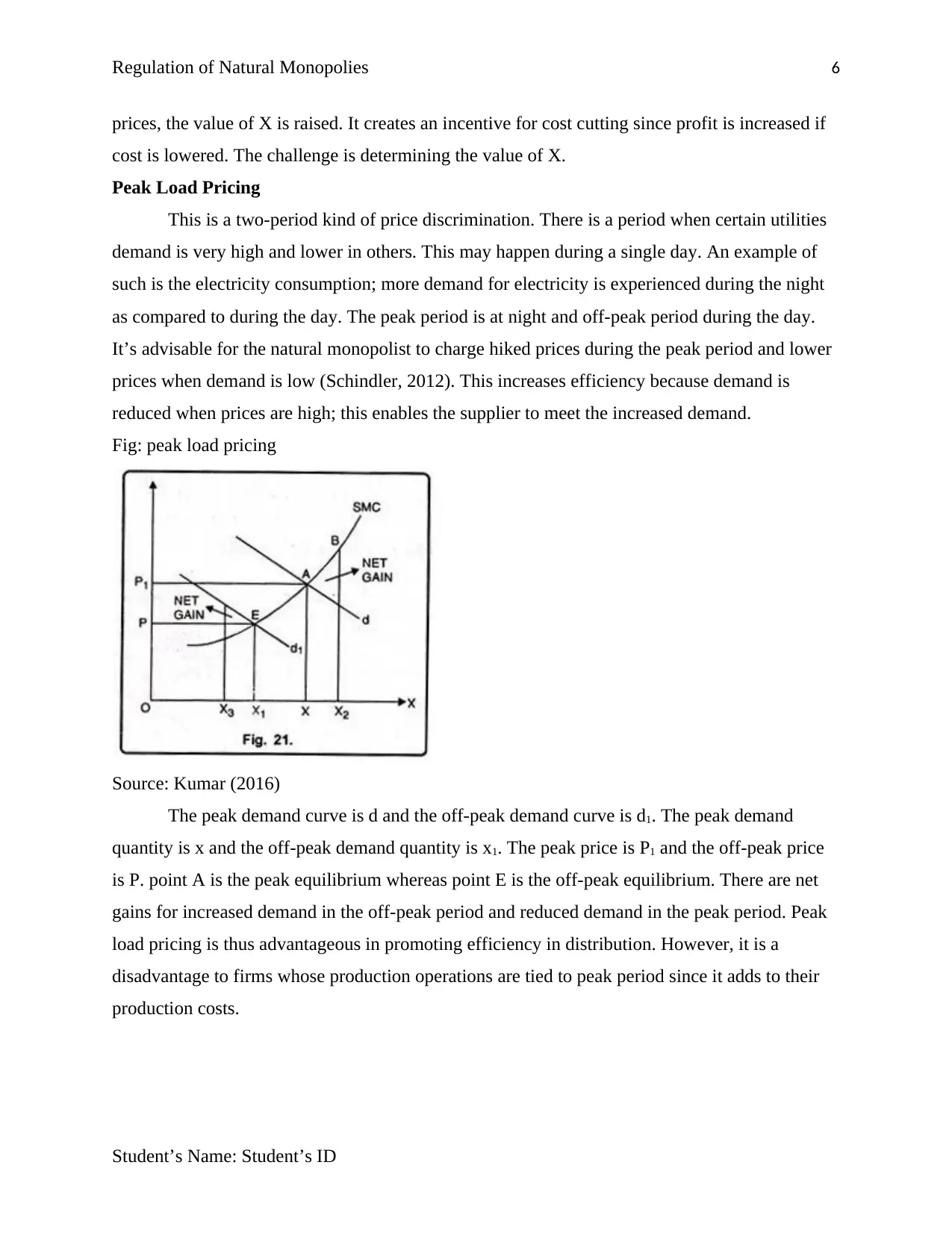
Regulation of Natural Monopolies 6
prices, the value of X is raised. It creates an incentive for cost cutting since profit is increased if
cost is lowered. The challenge is determining the value of X.
Peak Load Pricing
This is a two-period kind of price discrimination. There is a period when certain utilities
demand is very high and lower in others. This may happen during a single day. An example of
such is the electricity consumption; more demand for electricity is experienced during the night
as compared to during the day. The peak period is at night and off-peak period during the day.
It’s advisable for the natural monopolist to charge hiked prices during the peak period and lower
prices when demand is low (Schindler, 2012). This increases efficiency because demand is
reduced when prices are high; this enables the supplier to meet the increased demand.
Fig: peak load pricing
Source: Kumar (2016)
The peak demand curve is d and the off-peak demand curve is d1. The peak demand
quantity is x and the off-peak demand quantity is x1. The peak price is P1 and the off-peak price
is P. point A is the peak equilibrium whereas point E is the off-peak equilibrium. There are net
gains for increased demand in the off-peak period and reduced demand in the peak period. Peak
load pricing is thus advantageous in promoting efficiency in distribution. However, it is a
disadvantage to firms whose production operations are tied to peak period since it adds to their
production costs.
Student’s Name: Student’s ID
prices, the value of X is raised. It creates an incentive for cost cutting since profit is increased if
cost is lowered. The challenge is determining the value of X.
Peak Load Pricing
This is a two-period kind of price discrimination. There is a period when certain utilities
demand is very high and lower in others. This may happen during a single day. An example of
such is the electricity consumption; more demand for electricity is experienced during the night
as compared to during the day. The peak period is at night and off-peak period during the day.
It’s advisable for the natural monopolist to charge hiked prices during the peak period and lower
prices when demand is low (Schindler, 2012). This increases efficiency because demand is
reduced when prices are high; this enables the supplier to meet the increased demand.
Fig: peak load pricing
Source: Kumar (2016)
The peak demand curve is d and the off-peak demand curve is d1. The peak demand
quantity is x and the off-peak demand quantity is x1. The peak price is P1 and the off-peak price
is P. point A is the peak equilibrium whereas point E is the off-peak equilibrium. There are net
gains for increased demand in the off-peak period and reduced demand in the peak period. Peak
load pricing is thus advantageous in promoting efficiency in distribution. However, it is a
disadvantage to firms whose production operations are tied to peak period since it adds to their
production costs.
Student’s Name: Student’s ID
⊘ This is a preview!⊘
Do you want full access?
Subscribe today to unlock all pages.

Trusted by 1+ million students worldwide
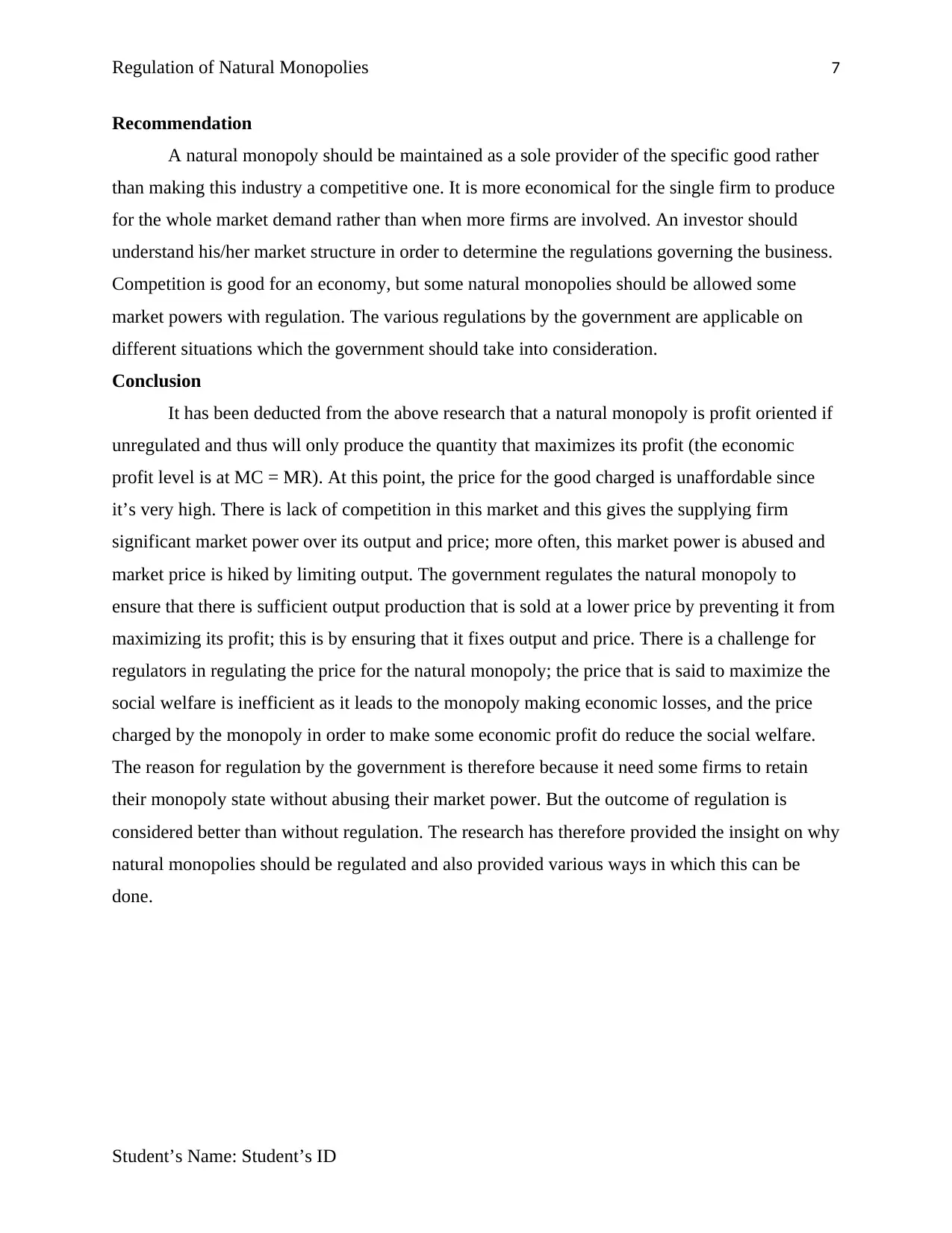
Regulation of Natural Monopolies 7
Recommendation
A natural monopoly should be maintained as a sole provider of the specific good rather
than making this industry a competitive one. It is more economical for the single firm to produce
for the whole market demand rather than when more firms are involved. An investor should
understand his/her market structure in order to determine the regulations governing the business.
Competition is good for an economy, but some natural monopolies should be allowed some
market powers with regulation. The various regulations by the government are applicable on
different situations which the government should take into consideration.
Conclusion
It has been deducted from the above research that a natural monopoly is profit oriented if
unregulated and thus will only produce the quantity that maximizes its profit (the economic
profit level is at MC = MR). At this point, the price for the good charged is unaffordable since
it’s very high. There is lack of competition in this market and this gives the supplying firm
significant market power over its output and price; more often, this market power is abused and
market price is hiked by limiting output. The government regulates the natural monopoly to
ensure that there is sufficient output production that is sold at a lower price by preventing it from
maximizing its profit; this is by ensuring that it fixes output and price. There is a challenge for
regulators in regulating the price for the natural monopoly; the price that is said to maximize the
social welfare is inefficient as it leads to the monopoly making economic losses, and the price
charged by the monopoly in order to make some economic profit do reduce the social welfare.
The reason for regulation by the government is therefore because it need some firms to retain
their monopoly state without abusing their market power. But the outcome of regulation is
considered better than without regulation. The research has therefore provided the insight on why
natural monopolies should be regulated and also provided various ways in which this can be
done.
Student’s Name: Student’s ID
Recommendation
A natural monopoly should be maintained as a sole provider of the specific good rather
than making this industry a competitive one. It is more economical for the single firm to produce
for the whole market demand rather than when more firms are involved. An investor should
understand his/her market structure in order to determine the regulations governing the business.
Competition is good for an economy, but some natural monopolies should be allowed some
market powers with regulation. The various regulations by the government are applicable on
different situations which the government should take into consideration.
Conclusion
It has been deducted from the above research that a natural monopoly is profit oriented if
unregulated and thus will only produce the quantity that maximizes its profit (the economic
profit level is at MC = MR). At this point, the price for the good charged is unaffordable since
it’s very high. There is lack of competition in this market and this gives the supplying firm
significant market power over its output and price; more often, this market power is abused and
market price is hiked by limiting output. The government regulates the natural monopoly to
ensure that there is sufficient output production that is sold at a lower price by preventing it from
maximizing its profit; this is by ensuring that it fixes output and price. There is a challenge for
regulators in regulating the price for the natural monopoly; the price that is said to maximize the
social welfare is inefficient as it leads to the monopoly making economic losses, and the price
charged by the monopoly in order to make some economic profit do reduce the social welfare.
The reason for regulation by the government is therefore because it need some firms to retain
their monopoly state without abusing their market power. But the outcome of regulation is
considered better than without regulation. The research has therefore provided the insight on why
natural monopolies should be regulated and also provided various ways in which this can be
done.
Student’s Name: Student’s ID
Paraphrase This Document
Need a fresh take? Get an instant paraphrase of this document with our AI Paraphraser
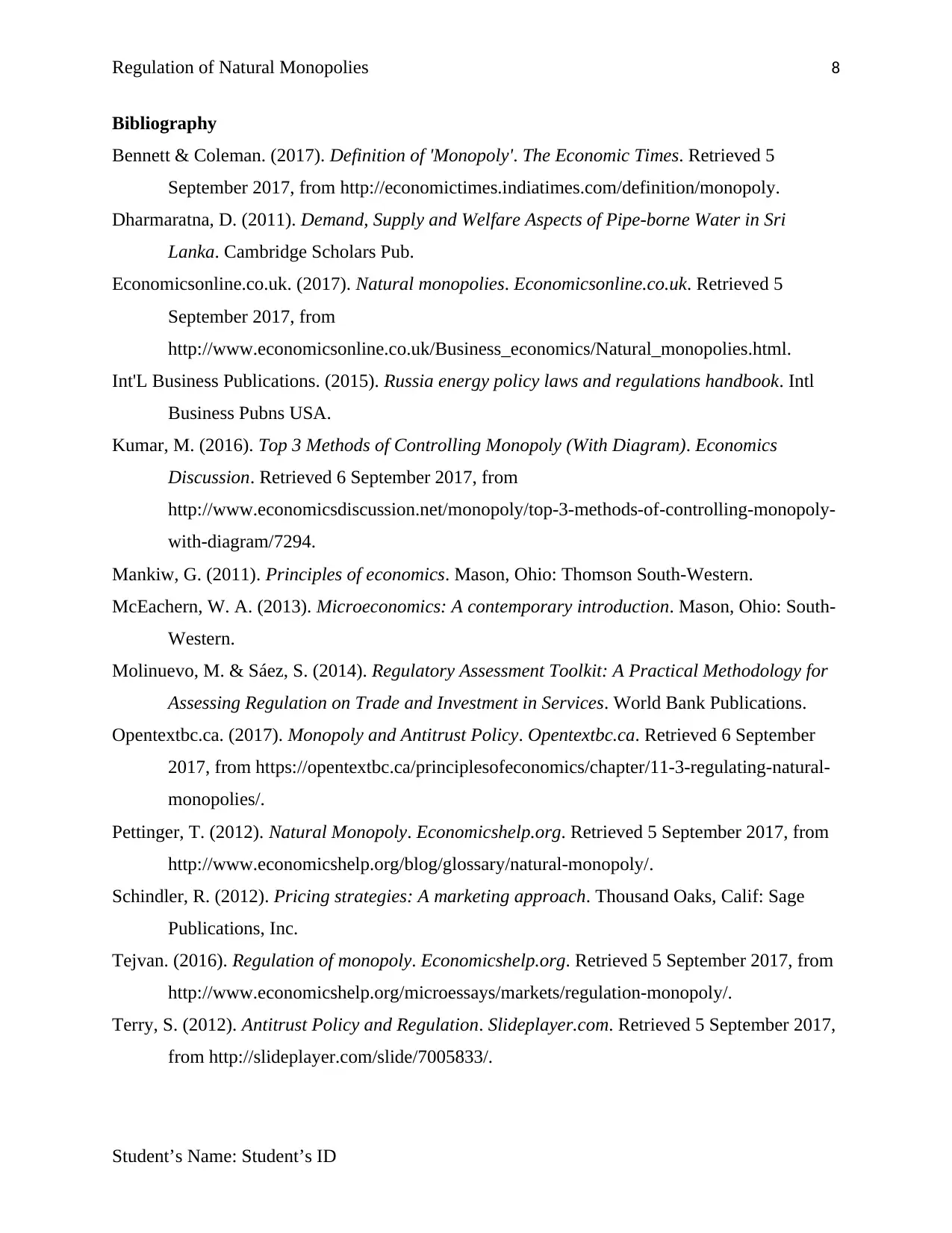
Regulation of Natural Monopolies 8
Bibliography
Bennett & Coleman. (2017). Definition of 'Monopoly'. The Economic Times. Retrieved 5
September 2017, from http://economictimes.indiatimes.com/definition/monopoly.
Dharmaratna, D. (2011). Demand, Supply and Welfare Aspects of Pipe-borne Water in Sri
Lanka. Cambridge Scholars Pub.
Economicsonline.co.uk. (2017). Natural monopolies. Economicsonline.co.uk. Retrieved 5
September 2017, from
http://www.economicsonline.co.uk/Business_economics/Natural_monopolies.html.
Int'L Business Publications. (2015). Russia energy policy laws and regulations handbook. Intl
Business Pubns USA.
Kumar, M. (2016). Top 3 Methods of Controlling Monopoly (With Diagram). Economics
Discussion. Retrieved 6 September 2017, from
http://www.economicsdiscussion.net/monopoly/top-3-methods-of-controlling-monopoly-
with-diagram/7294.
Mankiw, G. (2011). Principles of economics. Mason, Ohio: Thomson South-Western.
McEachern, W. A. (2013). Microeconomics: A contemporary introduction. Mason, Ohio: South-
Western.
Molinuevo, M. & Sáez, S. (2014). Regulatory Assessment Toolkit: A Practical Methodology for
Assessing Regulation on Trade and Investment in Services. World Bank Publications.
Opentextbc.ca. (2017). Monopoly and Antitrust Policy. Opentextbc.ca. Retrieved 6 September
2017, from https://opentextbc.ca/principlesofeconomics/chapter/11-3-regulating-natural-
monopolies/.
Pettinger, T. (2012). Natural Monopoly. Economicshelp.org. Retrieved 5 September 2017, from
http://www.economicshelp.org/blog/glossary/natural-monopoly/.
Schindler, R. (2012). Pricing strategies: A marketing approach. Thousand Oaks, Calif: Sage
Publications, Inc.
Tejvan. (2016). Regulation of monopoly. Economicshelp.org. Retrieved 5 September 2017, from
http://www.economicshelp.org/microessays/markets/regulation-monopoly/.
Terry, S. (2012). Antitrust Policy and Regulation. Slideplayer.com. Retrieved 5 September 2017,
from http://slideplayer.com/slide/7005833/.
Student’s Name: Student’s ID
Bibliography
Bennett & Coleman. (2017). Definition of 'Monopoly'. The Economic Times. Retrieved 5
September 2017, from http://economictimes.indiatimes.com/definition/monopoly.
Dharmaratna, D. (2011). Demand, Supply and Welfare Aspects of Pipe-borne Water in Sri
Lanka. Cambridge Scholars Pub.
Economicsonline.co.uk. (2017). Natural monopolies. Economicsonline.co.uk. Retrieved 5
September 2017, from
http://www.economicsonline.co.uk/Business_economics/Natural_monopolies.html.
Int'L Business Publications. (2015). Russia energy policy laws and regulations handbook. Intl
Business Pubns USA.
Kumar, M. (2016). Top 3 Methods of Controlling Monopoly (With Diagram). Economics
Discussion. Retrieved 6 September 2017, from
http://www.economicsdiscussion.net/monopoly/top-3-methods-of-controlling-monopoly-
with-diagram/7294.
Mankiw, G. (2011). Principles of economics. Mason, Ohio: Thomson South-Western.
McEachern, W. A. (2013). Microeconomics: A contemporary introduction. Mason, Ohio: South-
Western.
Molinuevo, M. & Sáez, S. (2014). Regulatory Assessment Toolkit: A Practical Methodology for
Assessing Regulation on Trade and Investment in Services. World Bank Publications.
Opentextbc.ca. (2017). Monopoly and Antitrust Policy. Opentextbc.ca. Retrieved 6 September
2017, from https://opentextbc.ca/principlesofeconomics/chapter/11-3-regulating-natural-
monopolies/.
Pettinger, T. (2012). Natural Monopoly. Economicshelp.org. Retrieved 5 September 2017, from
http://www.economicshelp.org/blog/glossary/natural-monopoly/.
Schindler, R. (2012). Pricing strategies: A marketing approach. Thousand Oaks, Calif: Sage
Publications, Inc.
Tejvan. (2016). Regulation of monopoly. Economicshelp.org. Retrieved 5 September 2017, from
http://www.economicshelp.org/microessays/markets/regulation-monopoly/.
Terry, S. (2012). Antitrust Policy and Regulation. Slideplayer.com. Retrieved 5 September 2017,
from http://slideplayer.com/slide/7005833/.
Student’s Name: Student’s ID
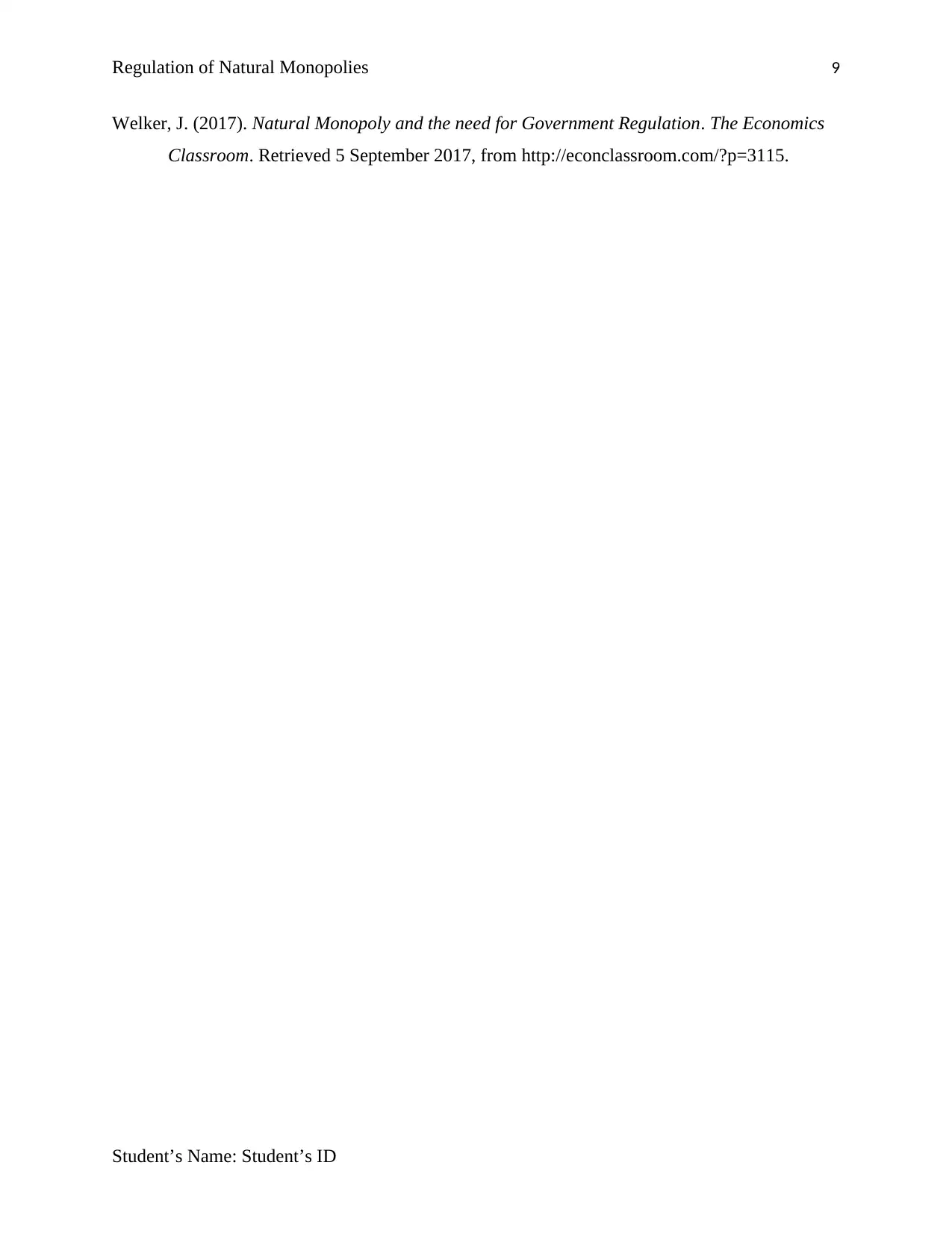
Regulation of Natural Monopolies 9
Welker, J. (2017). Natural Monopoly and the need for Government Regulation. The Economics
Classroom. Retrieved 5 September 2017, from http://econclassroom.com/?p=3115.
Student’s Name: Student’s ID
Welker, J. (2017). Natural Monopoly and the need for Government Regulation. The Economics
Classroom. Retrieved 5 September 2017, from http://econclassroom.com/?p=3115.
Student’s Name: Student’s ID
⊘ This is a preview!⊘
Do you want full access?
Subscribe today to unlock all pages.

Trusted by 1+ million students worldwide
1 out of 9
Related Documents
Your All-in-One AI-Powered Toolkit for Academic Success.
+13062052269
info@desklib.com
Available 24*7 on WhatsApp / Email
![[object Object]](/_next/static/media/star-bottom.7253800d.svg)
Unlock your academic potential
Copyright © 2020–2025 A2Z Services. All Rights Reserved. Developed and managed by ZUCOL.





